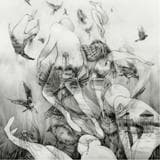
Mono (jap)
The Last Dawn
MONO evolved into an orchestral rock band and performed in prestigious venues in New York, London and Tokyo, with renowned orchestras by their sides. Following a wave of creative peaks, MONO regrouped and planned where to go next. This departure comes in the form of two albums; The Last Dawn and Rays of Darkness. Together but different. Side by side but opposites. The twin albums were recorded concurrently, yet conceptually and creatively, they are worlds apart. They are two sides to a story, but they remain hand in hand. Themes that have permeated MONOs previous output are revisited through the conjoined albums: hope and hopelessness, love and loss, immense joy and unspeakable pain. Whilst one hand soothes, the other wreaks havoc. The "light" side of this chapter in the MONO story is The Last Dawn. The pared down tracks take inspiration from influences as diverse as minimalist film scores and vintage shoegaze. Noticeably more stripped back than their previous releases, the album clocks in at under forty minutes; the succinct offering proffers the hope, love and joy in a neatly wrapped package. In direct contrast, Rays of Darkness is an altogether more ominous and brooding beast. Notable for the absence of MONOs near-trademark orchestral instruments, this album leans heavily on the aggression of blistering riffs, jarring angles, and a doom-layered undertone. Another dynamic is added by the involvement of post-hardcore pioneer, Tetsu Fukagawa of Envy; Tetsu provides vocals, for the first time ever on a MONO recording. The crescendos here seem all the more threatening, and the diminuendos feel that much more bleak.